
The Internet's Premier Classical Music Source
Related Links
- Latest Reviews
- More Reviews
-
By Composer
-
Collections
DVD & Blu-ray
Books
Concert Reviews
Articles/Interviews
Software
Audio
Search Amazon
Recommended Links
Site News
 Article
Article


The Leopold Stokowski Society and CALA
An Overview
by Robert Marion Stumpf, II
Curator: Leopold Stokowski Private Recording Lending Library
I was working on a five-part radio program, to be broadcast in April of 2004, on the life and music making of Leopold Stokowski. Whilst going through my library collection I realized that the Leopold Stokowski Society had then issued 20 CDs of the work of the Mysterioso. I decided it was high time for an overview.
First of all, the music spans an amazing amount of the work of Stokowski. There are over 100 different recordings covering the work of over 50 composers. They span almost a half century; from 1927 to 1975 (there are no acoustic recordings). Most of the recordings are with the Philadelphia Orchestra but also included are: the All-American Youth Orchestra, the NBC Symphony Orchestra, the New York City Symphony Orchestra, the New York Philharmonic Orchestra, the Hollywood Bowl Symphony Orchestra, the London Symphony Orchestra, the Hilversum Radio Philharmonic, the Czech Philharmonic and the National Philharmonic Orchestra. Phew.
I do not intend to provide a disc-by-disc discussion of the contents of all of the CDs. You can consult the Leopold Stokowski CDiscography for those (see the URL below). I will mention some of the pieces on each disc and focus on comments about the main fare on teach one. Ther is no special order here, only an arbitrary one I chose.
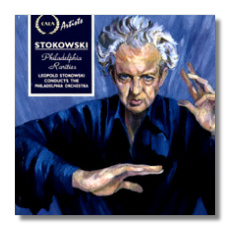
First Releases & Philadelphia Rarities (501 and 502) were released in 1994 and 1995 and are the first ones issued by the society in conjunction with CALA. The recordings span 1927 to 1944 and include the NBC Symphony and New York City Symphony along with the Philadelphia Orchestra. They include music from a variety of composers less or little known today including: Harl McDonald, Henry Eichheim, Joseph La Monaca and Robert Kelly. Perhaps the most interesting is Arcady Dubensky's (oratorio? I'm kidding) "The Raven" narrated by Benjamin de Loache. They also include music by Sousa and Stephen Foster (Oh, Susannah as orchestrated by Stokowski) along with some more standard fare by Tchaikovsky, Richard Strauss, and Schubert.
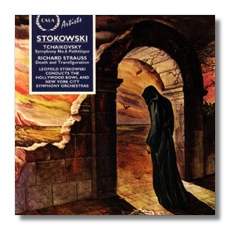
The next grouping includes CALA 506, 520, 523 and 527. 506 includes the Tchaikovsky "Pathétique" recorded with the Hollywood Bowl Symphony Orchestra in July of 1945 and Strauss' "Death and Transfiguration" recorded in December of 1944 with the New York City Symphony. Stokowski made three recordings of the "Pathétique" and this recording reflects Stokowski's more emotional (some would say willful) period of recording. I love the cover; it is taken from the RCA 78s used.
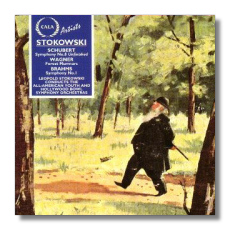
CALA 520 provides one of the first opportunities to listen to what Stokowski did with the Youth Orchestras he created and toured with in the first years of the 40s. (The very first issues were made by the 'gone but not forgotten' LSSA and are now on Music and Arts). Among the recordings he made with the kids was this Schubert "Unfinished" in July of 1941. The master was made from the original 33 1/3 rpm originals issued by Columbia, which was donated by yours truly. (How I got them is a story in itself). This is coupled with Wagner's "Forest Murmurs" and Brahms' Symphony #1 recorded with the Hollywood Bowl Symphony Orchestra in August of 1946 and August 1945 respectively. The cover offers a painting of Brahms strolling through a forest and is taken from the RCA cover used in their 1936 issue of the 1st recorded by Stokowski in Philadelphia.
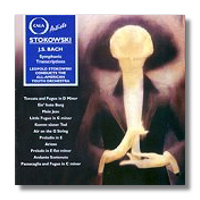
CALA 527 contains all of the Bach transcriptions that Stokowski recorded with the All-American Youth Orchestra. The sound here, as recorded by Columbia, is not as plush as you will hear on RCA discs but it is better than the originals and captures the Stokowski Sound. It includes the only recording Stokowski ever made of the Andante Sostenuto from the 3rd Sonata for Unaccompanied Violin. My notes reflect that at the time I felt the "Komm Susser Tod" brought to mind Elgar.
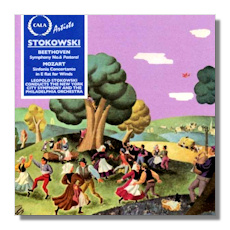
CALA 523 is an odd coupling, at least to my mind. It contains Mozart's Sinfonia Concertante recorded with the Philadelphia Orchestra in 1940 and Beethoven's "Pastoral" Symphony recorded with the New York City Symphony Orchestra in 1945. The Mozart is one of the last recordings Stokowski made with the Philadelphia Orchestra and features some of the finest soloists in the world: Marcel Tabuteau, oboe; Bernard Portnoy, clarinet; Sol Schoenbach, bassoon; and Mason Jones, horn.
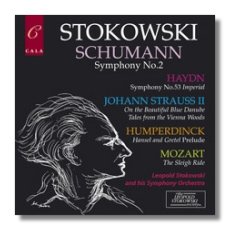
Next we come to the discs issued by the Leopold Stokowski Society in 2002. Number 532 contains music recorded with HIS Symphony Orchestra. The orchestra was an ad hoc group of musicians who worked for the NBC Symphony Orchestra and the New York Philharmonic at the time. They included some of the finest musicians around including Mason Jones on horn (as mentioned above) and Robert Bloom on oboe. Using tape Stokowski was able to metamorphose sound and transform 60 players to over 100. I have seen his handwritten comments on the recordings indicating what changes he wanted made to achieve this sound. The recordings were all made in 1949 except for the Schumann Symphony, which was recorded in 1950. What makes this disc particularly appealing is that it features two pieces rare in Stokowski's recorded repertoire. The Schumann was frequently programmed when Stokowski was in Philadelphia. What you will hear is an almost Elgarian feel to it. Haydn's Symphony #53 (Imperial) had been discovered only a few years before and Stokowski gave the U.S. première in New York just prior to this recording. The disc also contains Mozart's "Sleigh Ride" and two of Johann Strauss' waltzes.
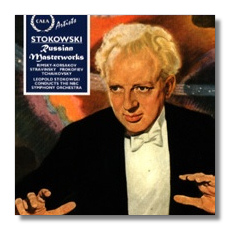

Toscanini had a conniption fit with NBC and quit, assuming that would force the company to meet HIS conditions for the orchestra (i.e. they would be HIS orchestra and not used as studio artists as well). NBC, to get even, hired Stokowski. The results were enough to bring Toscanini to his knees and provide the public with some of the best music they would hear (certainly better than the desert fare that had been being served). Okay, now that the editorial is out of the way… discs 505, 526 and 528 include music he made with the NBC Symphony Orchestra. In 1996 the society released the first disc and the most important item is the Tchaikovsky Symphony #4. It was recorded in November of 1941 during the same sessions when the orchestra committed to disc Prokfiev's march from "The Love for Three Oranges" (also on the disc). If you are familiar with Studio 8-H recordings of Toscanini you will immediately realize how much better the sound is already. The Tchaikovsky 4th is perhaps the best of Stokowski's three recordings with an intensity in the Scherzo that has never been matched. The next two discs contain music from live broadcasts. The Holst "The Planets" is the main fare on 526 and it is a stunning performance. The original broadcast included a narration introducing each 'planet' and this has fortunately been removed. The third disc includes music Stokowski performed only once in his career. I am surprised he didn't program Vaughan Williams 4th again. Stokowski brings to the music of his fellow countryman a feeling that stark as a moonless night. If this isn't about war then it is from something even more disturbing. The juxtaposition with Antheil's 4th, the last work on the disc, is an operational paradigm of excellent and merely good music. That is, I learned more about listening to the VW4 after hearing Anthiel's work. I suppose this may sound like a rather odd kind of compliment and reason to get the disc… so it goes.  .
.
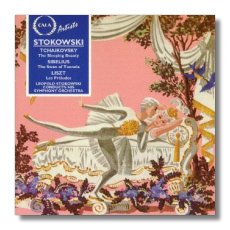
CALA 522, released in 1998, brings me back to HIS Symphony Orchestra. The Tchaikovsky "Sleeping Beauty" highlights is the main fare but the two other items are what I find most interesting. The Sibelius "Swan" features Mitchell (Mitch) Miller, later of 'Sing Along With Mitch' on television, playing the Cor Anglais. Of the four recordings made of this work, this one is perhaps the most brooding. Les Preludes is just the kind of music Stokowski could wallow in and he certainly pulls out all the stops here. This is the only time I have ever heard this music played as if it was good music and not just camp. It is my favorite recording of this music by Liszt.
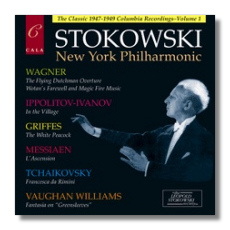
In 2002 the society issued two additional discs that are valuable as they include almost all of the recordings Stokowski made with the New York Philharmonic (533 and 534) The sound on these discs is simply amazing. There is a depth and breadth to it and air around the music. Volume One opens with Wagner's "The Flying Dutchman" Overture. You best have seatbelts on when you listen to it. Ippolitov-Ivanov's "Caucasian Sketches" follows with Michel Nazzi on the solo English horn and William Lincer the solo viola. Griffes' "The White Peacock" has been called his 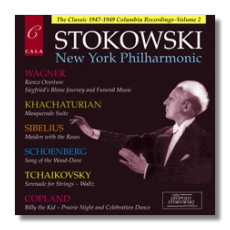 Adagio for Strings but it is a lovely piece. It is interesting that Stokowski persuaded Columbia to record Messiaen's "L'Ascension" and I am glad he did. The disc also contains another piece by Wagner, and music by Vaughan Williams and Tchaikovsky. Volume Two contains more Wagner and Tchaikovsky. The two most interesting items are Khachaturian's "Masquerade Suite". Then there the only music Stokowski ever recorded by Copland: from Billy the Kid we have one of the most sublime "Prairie Night" I have ever heard. I can imagine myself sitting outside on a black night and gazing at the 'billions and billions' of stars in the firmament. This is followed by the "Celebration Dance" Rumour has it that there is another New York Philharmonic disc in the future.
Adagio for Strings but it is a lovely piece. It is interesting that Stokowski persuaded Columbia to record Messiaen's "L'Ascension" and I am glad he did. The disc also contains another piece by Wagner, and music by Vaughan Williams and Tchaikovsky. Volume Two contains more Wagner and Tchaikovsky. The two most interesting items are Khachaturian's "Masquerade Suite". Then there the only music Stokowski ever recorded by Copland: from Billy the Kid we have one of the most sublime "Prairie Night" I have ever heard. I can imagine myself sitting outside on a black night and gazing at the 'billions and billions' of stars in the firmament. This is followed by the "Celebration Dance" Rumour has it that there is another New York Philharmonic disc in the future.
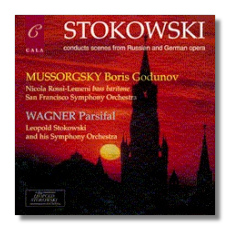
Moving on to another recording that includes HIS Symphony Orchestra we have 535. Wagner's "Parsifal" is played by the ad hoc group and is excellent. The gem, however, is Stokowski's recording with the San Francisco Symphony, made whilst he was a guest conductor there in 1952, of Boris Godunov. The Stokowski Society has outdone themselves here, producing a sound that you would swear is stereophonic. Nicola Rossi-Lemeni sings Boris and Vaarlam the Friar. This is simply fantastic music making. Singer and orchestra sound inspired in the Rimsky-Korsakov, not Stokowski version. Listening to it again, just now, I am stunned by the effects Stokowski brings to the music. I found myself muttering "wow" over-and-over again.
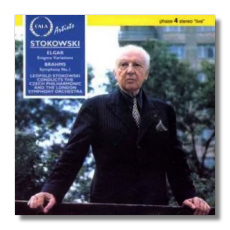
In 1999 the Stokowski Society released its first stereo compact disc (524) and it was an auspicious debut. They licensed from Decca the rights to produce Elgar's "Enigma" Variations, recorded with the Czech Philharmonic, coupled with the live Brahms First Symphony with the LSO. This is Stokowski's only recording of Elgar and you only have to listen to the Nimrod to feel the passion Stokowski brings to this 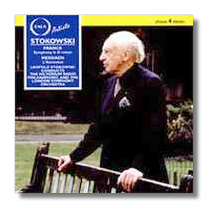 piece. Also that year the society released (525 of course) another Decca recording. The gem here is Franck's Symphony. Stokowski was, as you probably know an organist and he brings that feel from the Hilversum Radio Philharmonic Orchestra. This disc is a must have for this alone and there is much more music with it, including Messiaen's "L'Ascension".
piece. Also that year the society released (525 of course) another Decca recording. The gem here is Franck's Symphony. Stokowski was, as you probably know an organist and he brings that feel from the Hilversum Radio Philharmonic Orchestra. This disc is a must have for this alone and there is much more music with it, including Messiaen's "L'Ascension".
Now we come to my personal favorite top four recordings. The first two are from recordings leased from SONY. Stokowski's last recordings were with that label (then called Columbia) with the National Philharmonic. Both of these CDs were released in 2001. 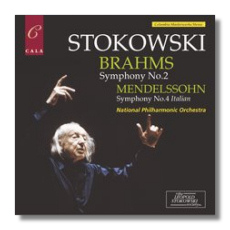 531 includes the Brahms' Symphony #2 in Stokowski's autumnal interpretation, which is not only a valid one but perhaps more in tune (pun?) with the spirit in the music on the page. It is coupled with Mendelssohn's Symphony #4 "Italian". This was one of two of Stokowski's final recordings, made in 1977. The sound on the LP was thin and did not have the Stokowski Sound. I was disappointed in it and wondered if the Mysterioso was at the end and just couldn't master the orchestra any more. The sound here proves that whoever produced that LP was an idiot. Everything comes alive and is truly "Italian". Earlier that year (we are going 4-1 in preferences) the Stokowski Society released a fantastic recording full of music. Stokowski could do Tchaikovsky better than anyone and the sound on "Aurora's Wedding" adds to a stunning, passionate performance. Add to that 9 of Stokowski's transcriptions for orchestra, including a truly menacing "Flight of the Bumble Bee" and a "Clair de Lune" that you would swear Debussy had orchestrated, and you have an evening's music that you will love.
531 includes the Brahms' Symphony #2 in Stokowski's autumnal interpretation, which is not only a valid one but perhaps more in tune (pun?) with the spirit in the music on the page. It is coupled with Mendelssohn's Symphony #4 "Italian". This was one of two of Stokowski's final recordings, made in 1977. The sound on the LP was thin and did not have the Stokowski Sound. I was disappointed in it and wondered if the Mysterioso was at the end and just couldn't master the orchestra any more. The sound here proves that whoever produced that LP was an idiot. Everything comes alive and is truly "Italian". Earlier that year (we are going 4-1 in preferences) the Stokowski Society released a fantastic recording full of music. Stokowski could do Tchaikovsky better than anyone and the sound on "Aurora's Wedding" adds to a stunning, passionate performance. Add to that 9 of Stokowski's transcriptions for orchestra, including a truly menacing "Flight of the Bumble Bee" and a "Clair de Lune" that you would swear Debussy had orchestrated, and you have an evening's music that you will love.
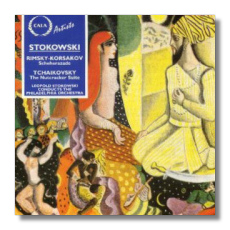
Now we come to the second and first choices. Schéhérazade is not my favorite piece of music. Perhaps it is because I have heard it so often. There are several good recordings around, but every time I hear Stokowski play it, it is as if I am hearing the music for the first time. In 1997 the Stokowski Society issued CALA 521. It is a marvelous program, beginning with the 1934 Nutcracker (a piece of music that I can stomach only in Stokowski's recordings… everyone else treats it like some saccharine pastry that gags me). At the end of the disc is the 1934 Scher. You don't hear playing like this anymore. The portamento swells are magical. Alexander Hilsberg plays a sensuous Schereherazade and CALA has provided excellent sound. Then we come to perhaps Stokowski's greatest recording. In 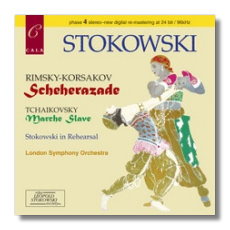 1964 Decca, using their Phase 4 techniques for recording, produced what was the best sounding Scher of all time. The London Symphony plays as if inspired or transfixed by some magical force to play as never before or since. This was released on a Decca Ovation CD some years ago, but CALA has produced a sound so much better than that it boogers the imagination. This is a must have disc for everyone and not just Stokowski fans.
1964 Decca, using their Phase 4 techniques for recording, produced what was the best sounding Scher of all time. The London Symphony plays as if inspired or transfixed by some magical force to play as never before or since. This was released on a Decca Ovation CD some years ago, but CALA has produced a sound so much better than that it boogers the imagination. This is a must have disc for everyone and not just Stokowski fans.
Of all of the discs the society has released there are some I recommend more than others. Everyone should have the two New York Philharmonic discs. The sound is fantastic, selections rare and performances among the best the Mysterioso ever committed to disc. The Tchaikovsky/Encores disc is simply a beauty. The San Francisco Boris leaves me speechless. Of course I recommend the two Schers.
URLs:Copyright © 2004, Robert Stumpf II














